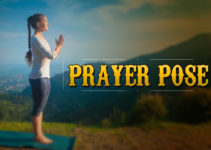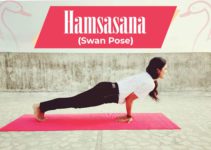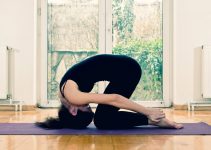- Meaning
- Precautions & Contraindications
- Steps
- Modification
- Ardha Baddha Padma Paschimottanasana Benefits
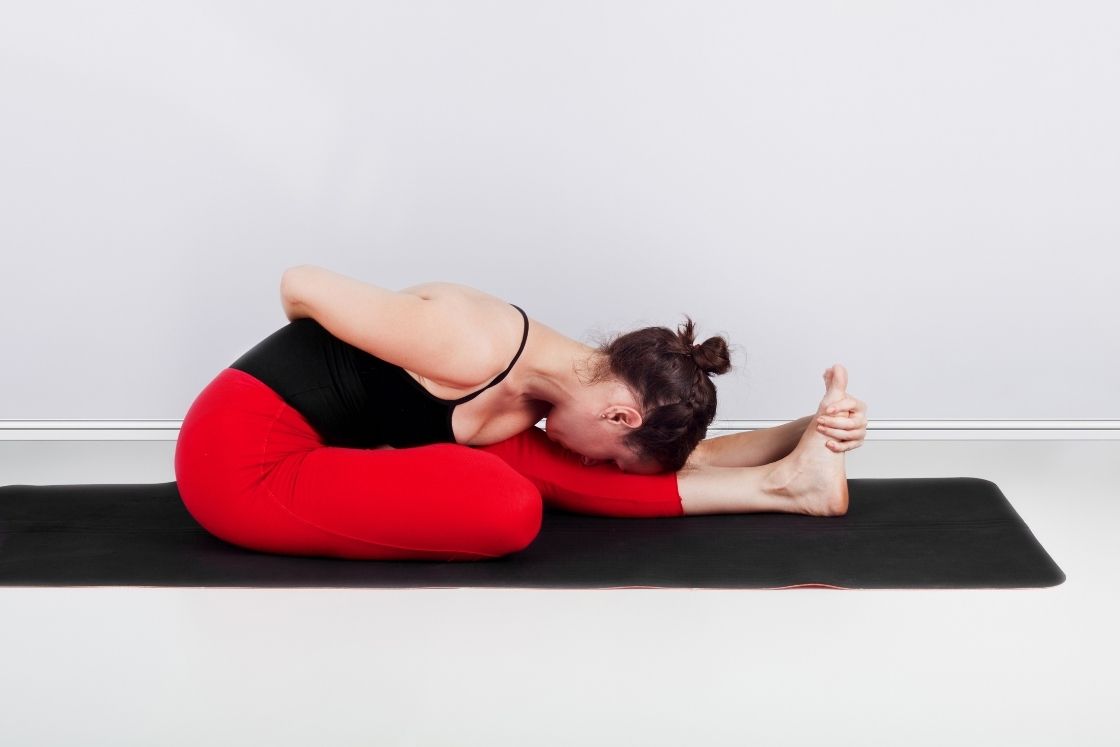
Ardha baddha padma paschimottanasana is an intense seated forward bend pose that acts as a hip opener. It is an advanced posture that has characteristics of Ardha padmasana along with Paschimottanasana.
This posture targets stretching the muscles of the neck, spine, hamstrings, and quadriceps. It acts as a flexibility enhancer in the knee and hip joints. Besides this, the forward fold stimulates the abdominal organs to enhance their efficiency.
This asymmetrical stretching posture is included in the primary sequence of the Ashtanga Yoga.
Meaning
Ardha baddha padma paschimottanasana meaning comprises the name of the variant of two classical pose – Ardha baddha padmasana + Paschimottansana.
- Ardha’ means ‘Half’
- ‘Baddha’ means ‘Bound’
- ‘Padma’ is ‘Lotus’
- ‘Paschim’ refers to ‘West’ (here, lower back)
- ‘Uttana’ is ‘Intense stretch’
- ‘Asana’ means ‘Pose’
In this pose, one leg is kept at half lotus pose position (ardha padmasana) where the lotus leg is locked from the same side hand behind back (Baddha). Then with this posture, trunk is bent forward just like in ‘seated forward bend pose’ Paschimottanasana. It’s also called half-bound lotus forward bend pose.
These root terms better describe the pose to understand its significance. The deep stretches involved with breathing also soothes the nervous system and relieves fatigue, stress, and anxiety.
Ardha Baddha Padma Paschimottanasana Practice Guide
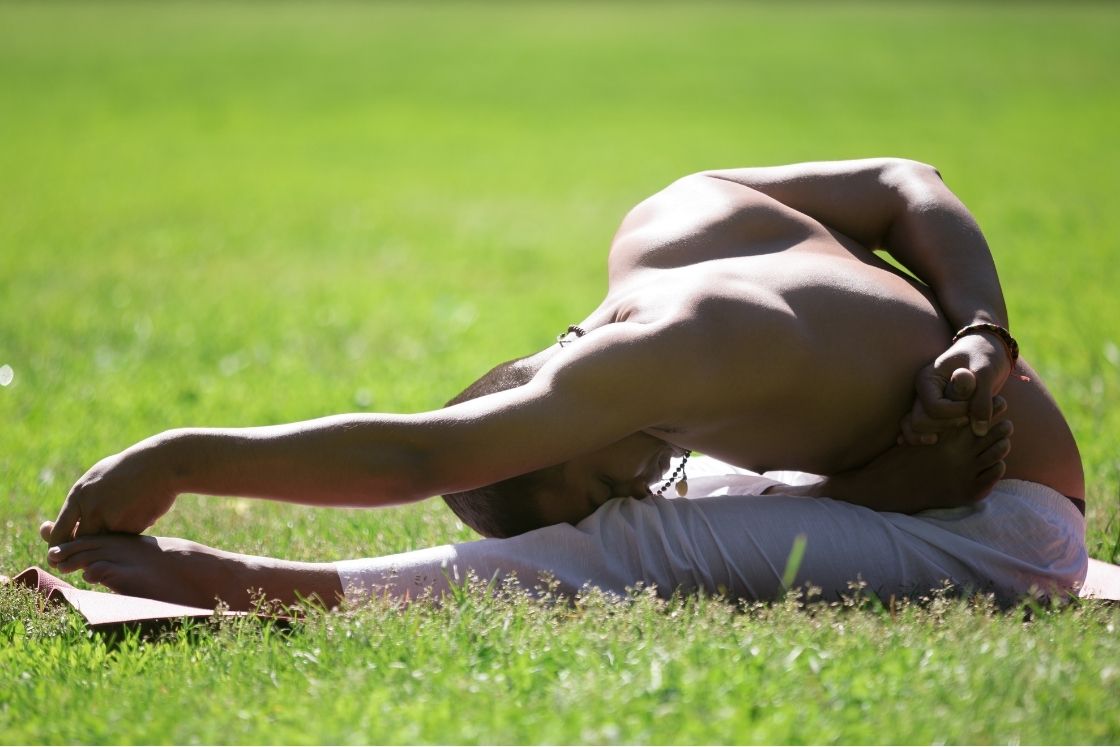
Precautions & Contraindications
- Do not practice this asana if you have an injury in and around kneecaps, shoulders, neck, back, hips, and ribs.
- Avoiding Ardha baddha padma paschimottanasana in the case of a slipped disc.
- Do not practice the pose during pregnancy or menstruation.
- First master Paschimottanasana then go deep in this pose.
- Do not arch your back or bend your knee while folding forward.
Preparatory poses
- Reclining Cobbler’s Pose (Supta Baddha Konasana)
- Head-to-Knee Pose (Janu Sirsasana)
- Garland Pose (Malasana)
- Cow Pose (Bitilasana)
Ardha Baddha Padma Paschimottanasana Steps
- Begin sitting in dandasana.
- Bend your left knee.
- Place your left foot on your upper right thigh., ensuring that the left knee touches the ground.
- Draw your left hand back and wrap it around your waist.
- Try to grab your left foot with the left hand.
- Relax your shoulders, inhale, and raise your right overhead.
- Exhale bend forward to your right foot by your right hand.
- Touch your chin on the right shin and keep gazing your toes or the nose.
- Hold the pose and take five deep breaths.
- Inhale lifting your chin and body to the center.
- Exhale lower the right arm to the side and release your left foot.
- Stretch both the legs and repeat the same with alternate leg bending.
- Then, relax in dandasana.
Beginner’s tips
- Bring your bent knee inwards so that the toes reach the hip crease and the knee touches the ground.
- If you are unable to reach your toe by wrapping the hands to the back, first, raise your hand, then twist by the shoulder as much as possible. This opens the shoulder and makes reach the foot reachable.
- Ensure to keep the chin to the shin, not the forehead. This also helps in preventing the misalignment of the spine.
Counter Poses
- Three-Limbed Forward Bend (Trianga Mukhaikapada Paschimottanasana)
- Head-to-knee-pose (Janu Sirsasana)
Modifications
To ease the forward bending in half-bound lotus pose, try these props to modify the base pose;
- Yoga block – Place a yoga block under the bent knee to support the foot on the alternate thigh. It adjusts the foot so that the ankle won’t bother you while bending forward.
- Yoga strap – Wrap a strap around the foot after placing it on the thigh. Grab it by bringing the hand from behind rather than holding the foot. It is helpful when you are unable to reach your foot.
Ardha Baddha Padma Paschimottanasana Benefits
1.Increases flexibility
This asana involves the expansion of muscles of the spine, hips, and legs. It stretches the knee and shoulder joints and improves blood flow in these areas. It makes the muscle stronger and enhances its elasticity.
2. Facilitates digestion
The forward bend involved in the posture causes contraction of the abdominal organs. It stimulates the functioning of the pancreas, liver, and stomach. This aids in increasing the efficiency of the digestive system.
Ardha baddha padma paschimottanasana has therapeutic action on digestive ailments like constipation, gastric disorders, etc.
3. Solution to obesity
By stimulating the functioning of the liver, it helps in the digestion of fats. This eventually benefits the metabolic rate. Besides this, it’s a great workout for the internal organs and muscles. This leaves the body toned by burning the extra body fat.
4. Increases immunity
Ardha baddha padma paschiottanasana has a deep influence on the spleen, as the heel is tucked into the abdomen while bending forward. This activates the functioning of the spleen, thereby, improving the immunity of the practitioner.
5. Stimulates uterus and ovaries
The perks of this asana are its influence on the uterus and ovaries. It enhances its functions by improving the hormonal balance. Therefore, ardha baddha padma paschiottanasana is beneficial in maintaining the health of the female reproductive system.
It also acts as a remedial pose for alleviating the menstrual discomfort and symptoms of menopause.
6. Therapeutic action
Along with stimulating the abdominal organ kidney also gets benefits by practicing ardha baddha padma paschiottanasana. This helps to improve the hormonal balance and cleansing of the body internally.
Besides this, it helps in maintaining the blood pressure of the practitioner and also prevents diabetes. People with insomnia also find it beneficial to improve their sleep patterns.
